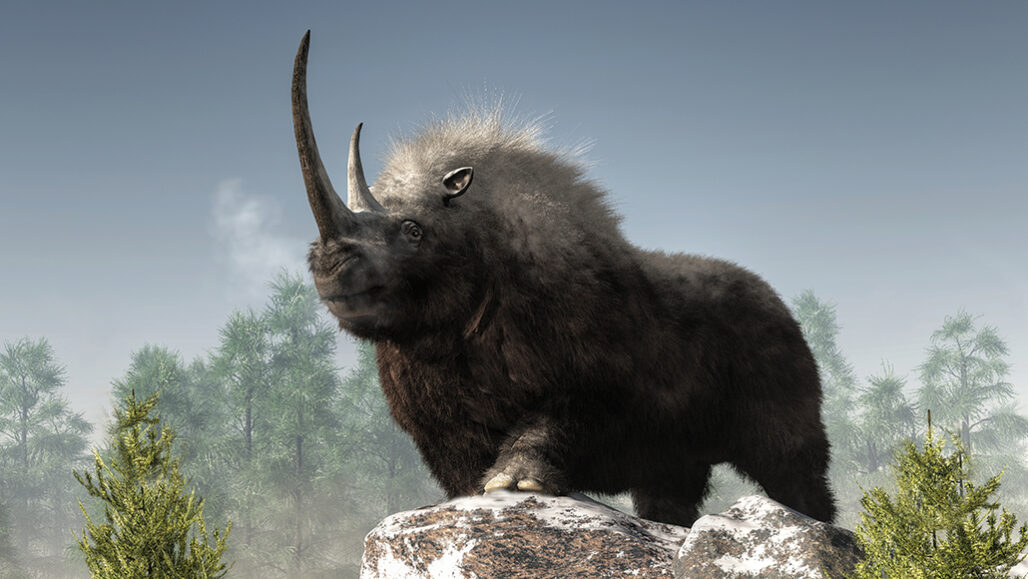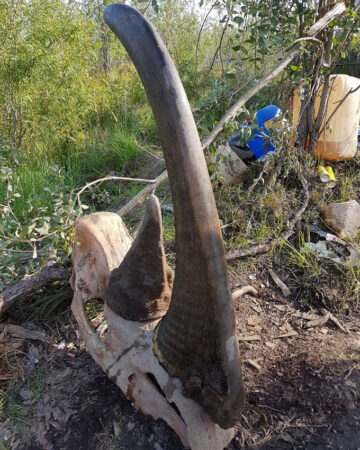Ancient DNA indicates the creatures’ numbers stayed mostly constant long after people showed up

Ancient DNA suggests that rising temperatures, not human hunters, wiped out woolly rhinos (illustrated). DANIEL ESKRIDGE/ISTOCK/GETTY IMAGES PLUS
By Bruce Bower
AUGUST 13, 2020 AT 11:00 AM
Rather than getting wiped out by Ice Age hunters, woolly rhinos charged to extinction in Siberia around 14,000 years ago when the climate turned warm and wet, a study of ancient DNA suggests.
Numbers of breeding woolly rhinos stayed relatively constant for tens of thousands of years until at least about 18,500 years ago, more than 13,000 years after people first reached northeastern Siberia, scientists report online August 13 in Current Biology. Yet only a few thousand years later, woolly rhinos died out, probably because temperatures had risen enough to reshape arctic habitats.
These findings build on a previous argument, based on dated fossils, that woolly rhino populations across northern Eurasia began to decline between 40,000 and 35,000 years ago, with surviving animals moving progressively eastward and dying out in northeastern Siberia around 14,000 years ago. Reasons for initial population losses are unclear, though there’s little evidence that human hunters killed substantial numbers of woolly rhinos, the researchers say.
Instead, a shift to warm, rainy conditions, which occurred between roughly 14,600 and 12,800 years ago, “likely played a large role in the rapid decline of this cold-adapted species,” says study coauthor Edana Lord, an evolutionary geneticist at the Centre for Palaeogenetics in Stockholm. During that climate shift, open expanses featuring vegetation that woolly rhinos (Coelodonta antiquitatis) liked to eat were replaced by forests and shrub-dominated tundra. Hunters could have added to woolly rhinos’ woes, but the main extinction distinction goes to climate change, Lord contends.
Researchers have argued for decades about whether climate change or human hunting had a larger effect on worldwide extinctions of large animals such as woolly rhinos and mammoths as the Pleistocene Ice Age approached its end around 11,700 years ago (SN: 11/13/18).
Few examples of ancient DNA have been gleaned from any large Ice Age animals that died out, including woolly rhinos, says evolutionary geneticist Pontus Skoglund of the Francis Crick Institute in London, who did not participate in the analysis. Based on the new study, he says, “there is no evidence so far of human hunting being a deciding factor in woolly rhino extinction.”

A woolly rhino skull shows the short and the long of this extinct creature’s horns.SERGEY FEDOROV
Lord’s group extracted a complete set of nuclear DNA, which is inherited from both parents, from a roughly 18,530-year-old woolly rhino bone. The researchers also isolated woolly rhino mitochondrial DNA, typically inherited from the mother, from 12 fossil bones, a piece of mummified tissue and a strand of hair. Those samples date from 14,100 to more than 50,000 years ago.
An analysis of molecular alterations in mitochondrial DNA samples indicated that two maternal lineages had split from a common ancestor between about 86,000 and 22,000 years ago. That finding supports a scenario consistent with fossil evidence, the researchers say, in which migrating animals settled in two northeast Asian regions, each with a suitable arctic environment. Mitochondrial DNA couldn’t resolve whether numbers of breeding females increased or remained stable around the time of that split.
Based on a comparison of sections of nuclear DNA that contained gene pairs with either matching or differing molecular compositions, the investigators calculated the approximate size of past breeding populations. Woolly rhino breeding numbers increased gradually starting around 1 million years ago and, by about 152,000 years ago, reached a peak of roughly 21,000 animals.
Humans entered northeastern Siberia by around 31,600 years ago (SN: 6/7/19). It’s not known when people first inhabited Siberia year-round, but the new DNA analysis shows that woolly rhinos continued to thrive long after mobile human groups likely knew of the animals’ existence. From around 29,700 to 18,530 years ago, when the animal that yielded nuclear DNA was alive, breeding woolly rhinos numbered about 10,600, the team estimates. Nuclear DNA from woolly rhinos that lived between around 18,000 and 14,000 years ago will be needed to determine when in that brief window of time the population of these animals plummeted.
A range of woolly rhino genes displayed molecular structures that may have helped the animals survive in an arctic environment. One of those genes contributes to cold tolerance. Another gene is involved in the perception of coldness. In a warming environment, Lord suggests, genes tuned to an arctic climate proved a liability.
Questions or comments on this article? E-mail us at feedback@sciencenews.org
CITATIONS
E. Lord et al. Pre-extinction demographic stability and genomic signatures of adaptation in the woolly rhinoceros. Current Biology. Published online August 13, 2020. doi: 10.1016/j.cub.2020.07.046.

About Bruce Bower
Bruce Bower has written about the behavioral sciences for Science News since 1984. He writes about psychology, anthropology, archaeology and mental health issues.
Lord’s group extracted a complete set of nuclear DNA, which is inherited from both parents, from a roughly 18,530-year-old woolly rhino bone. The researchers also isolated woolly rhino mitochondrial DNA, typically inherited from the mother, from 12 fossil bones, a piece of mummified tissue and a strand of hair. Those samples date from 14,100 to more than 50,000 years ago.
An analysis of molecular alterations in mitochondrial DNA samples indicated that two maternal lineages had split from a common ancestor between about 86,000 and 22,000 years ago. That finding supports a scenario consistent with fossil evidence, the researchers say, in which migrating animals settled in two northeast Asian regions, each with a suitable arctic environment. Mitochondrial DNA couldn’t resolve whether numbers of breeding females increased or remained stable around the time of that split.
Based on a comparison of sections of nuclear DNA that contained gene pairs with either matching or differing molecular compositions, the investigators calculated the approximate size of past breeding populations. Woolly rhino breeding numbers increased gradually starting around 1 million years ago and, by about 152,000 years ago, reached a peak of roughly 21,000 animals.
Humans entered northeastern Siberia by around 31,600 years ago (SN: 6/7/19). It’s not known when people first inhabited Siberia year-round, but the new DNA analysis shows that woolly rhinos continued to thrive long after mobile human groups likely knew of the animals’ existence. From around 29,700 to 18,530 years ago, when the animal that yielded nuclear DNA was alive, breeding woolly rhinos numbered about 10,600, the team estimates. Nuclear DNA from woolly rhinos that lived between around 18,000 and 14,000 years ago will be needed to determine when in that brief window of time the population of these animals plummeted.
A range of woolly rhino genes displayed molecular structures that may have helped the animals survive in an arctic environment. One of those genes contributes to cold tolerance. Another gene is involved in the perception of coldness. In a warming environment, Lord suggests, genes tuned to an arctic climate proved a liability.
Questions or comments on this article? E-mail us at feedback@sciencenews.org
CITATIONS
E. Lord et al. Pre-extinction demographic stability and genomic signatures of adaptation in the woolly rhinoceros. Current Biology. Published online August 13, 2020. doi: 10.1016/j.cub.2020.07.046.

About Bruce Bower
Bruce Bower has written about the behavioral sciences for Science News since 1984. He writes about psychology, anthropology, archaeology and mental health issues.
No comments:
Post a Comment